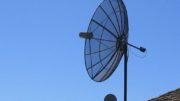Maybe you’ve seen it around town. In the last year or so, DIRECTV has been using a new mounting system for its Slimline dishes. The new “Stub” mount (pictured above) doesn’t require monopole braces like the older mount, because it’s so low that it doesn’t sway as much. It’s available at Solid Signal of course, and you can buy everything from just the mount to a complete dish system. The only question is… should you?
When should you use a stub mount?
The stub mount is a good choice for areas that aren’t that windy. It’s not ever going to be 100% as stable as a mount that has braces, but it is going to do just fine in most situations. Where it’s going to do best, though, is in steeply pitched roofs that face southward (or toward the satellites, which is southward for most people in the continental United States. If the roof doesn’t have enough pitch, then snow, leaves, or other “stuff” could pile up in front of the dish to the extent that signal can be affected. That’s the real issue you want to worry about.
If you do find yourself in a situation where the stub mount works for you, you’ll find it a lot easier to install. It’s more solid and moves less than a traditional J-mount, and it’s going to make fewer holes in the roof by virtue of not needing those braces. You’ll be done with the install a lot faster, especially if you’re putting in a new dish. The dish systems today feature fewer moving parts and they go together in new ways that keep them just as solid while you spend less time bolting them together. About five years ago, DIRECTV started working to cut down the time techs needed for each install. The stub mount was one part of that. It takes less time to assemble and requires less installation. Even if you’re a DIY type, you’ll benefit from the extra engineering put into the stub mount.
Before you mount to the roof…
Personally, I don’t favor mounting to the roof if there’s any way around it. Yes you can be as careful as possible, use the proper pitch pad and put as much extra sealer as you want in there, but there’s no way around it… sooner or later there is going to be an issue. Maybe it comes when you upgrade your dish or (gasp) change television services. Maybe it’s just the result of a once-in-a-century storm. But personally I prefer mounting to the side of the house if possible, using an appropriate gable or under-eave mount. You always want to think about how water could get in where it shouldn’t, and you always want to avoid any situation where you’re deliberately letting water in if you’re up north where that water could freeze and create problems.
But, I’ll say it again… if mounting to the roof is your choice, and if you’ve got a decent slope on that roof and you’re not inclined to have it get covered with leaves or other “stuff…” you might want to investigate the stub mount. It’s a much easier install and as I said… available at Solid Signal.





